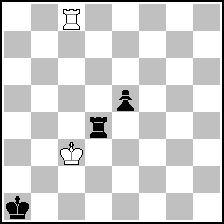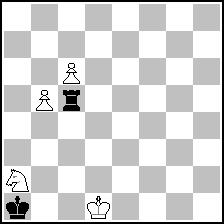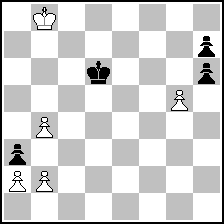
Website founded by
Milan Velimirović
in 2006
4:53 UTC


| |
MatPlus.Net  Forum Forum  General General  Thoughts on the Study of the Year... Thoughts on the Study of the Year... |
| |
|
|
|
|
You can only view this page!
| | Page: [Previous] [Next] 1 2 | | (21) Posted by Marek Kwiatkowski [Wednesday, Nov 4, 2009 03:10] |
Thanks Siegfried, but the main question of my post is other:
Which possibility in the Kalandadze’s study is recognized as a dual 10 Sa5 and next 11.Sc6 or 10.Sa5 and next 11.Sb7, both with mate in 6 moves. I believe that it is worth to explain before the end of this topic.
| | | (22) Posted by Sergiy Didukh [Wednesday, Nov 4, 2009 15:57] |
Marek, you have chosen the wrong method to defend ‘the masterpiece’. Your claim that ‘A dual would occur here, if the first way has been shorter than the second one’ is not right at all. When both paths are of the same length it’s a proof that we have a dual.
The only way to acquit this study of dual lies in trying to prove that Na5 wastes time comparing to Nc5. The main line goes 10.Nc5 Ka2 11.Nd3 Ka1 12.Nc1. Now a good lawyer should point out that:
if 10.Na5 Ka2 11.Nc6 Ka1 12.Nd4 Ka2 13.Ne2 Ka1 14.Nc1 – the knight gets to c1 two moves later;
if 10.Na5 Ka2 11.Nb7 Ka1 12.Nc5 – the knight gets to c5 again two moves later.
Still it’s a dual but some study composers consider them not serious.
Anyway, it’s better to select for SOTY a study without duals.
There’s a more important thing about this study than a talk about duals – its content.
The judge of Nona-2008 D.Gurgenidze commented that it’s a synthesis of different ideas in the light and miniature setting. I will precise these ideas: pure Queen sacrifice, underpromotion and mate. This kind of consecutive synthesis doesn’t look nice when ideas are very different. Taking a piece which didn’t make a move is not nice either. Geometry is spoiled by this little dual.
So, what is nice here? Do you still think it’s a masterpiece?
| | | (23) Posted by Kevin Begley [Wednesday, Nov 4, 2009 17:56]; edited by Kevin Begley [09-11-04] |
Marek,
With all sincere respect...
I'm quite aware that I am completely out of my depth discussing this genre here...but, two points bother me:
1) I am not familiar with your technical term, "quasi-dual."
Whereas a dual might trashcan a masterpiece, a "quasi-dual" can allow this "quasi-anticipated" 3-move introduction, to a fully-anticpated directmate, to be named Study of the Year?
That's marvelous! If you'd only define this, I could produce studies where exclamation points -- signifying only "short cut" -- grow like all the corn in Nebraska (and 7 throws in 22 are cattlefeed).
It seems to me that, "quasi-" is a term used to describe a dual which some well-respected (perhaps beyond the law) judge is willing to overlook! And, nobody will provide an algorithm to discern this terminology -- the kind of algorithms which problem composers, in all other genres, must live and die under! -- because hey, what is paramount in studies is, well, God Save the Judge's "feelings."
Which brings us to:
2) the Mojometer (techniques to measure a masterpiece):
I don't dispute that this 3 move introduction -- and let's be clear, that encapsulates the "depth" of this composition -- is highly creative, and I did think it provided a fresh, new perspective (until we learned this was shown 16 years prior, and the superior version earned no distinction!).
The lack of depth was a drip.
The dual was busted water pipe.
The anticipation is a flood.
I'd like to hear evacuation plans, while you're here calling the water "quasi-dry."
Look, I don't think anybody would dispute there is "artistry" to the composition...
But, I must say, what tragic methods have been suggested for judging!
Instead of objective methods -- like the kind Siegfried elucidates -- some would have us gather up focus groups of 11 year olds, and measure pupil dialation. You're telling me *some* people can sorta "feel" it.
The wreckless (almost pompass) presumption concealed: those who disagree with this particular Roycroft judgement (virtually everybody I talk to!) might never aquire these fine senses.
Remember in Cool Hand Luke, when the bloodhounds ran across that concoction of chili powder, pepper, and curry?
I see the same antics here, and you have no idea how badly I wish I could just laugh... like them kids do.
| | | (24) Posted by Georgy Evseev [Thursday, Nov 5, 2009 11:33] |
Some thoughts concerning study of the year.
Now we have got fourth award of this kind. Anв it looks like we are seeing the degradation of idea.
SOTY 2005 was brilliant. It was absolutely adequate to the goals declared - at the same time very original, very chess-like, very subtle and very accessible.
SOTY 2006 was nothing of this kind. It may be considered as a "letztform" of idea, but the idea was quite old and earlier realisations already existed. Maybe, it was quite interesting for those who never seen studies, but by idea the study looks more like a composition from the middle of 20th century.
SOTY 2007 had no pointed play. It was a good study, interesting to look at or to solve, but in no case unforgettable experience. I think that most of those who had seen it exactly as "SOTY 2007" have already forgeotten about it.
SOTY 2008 is simply to disgrace to all study composition. I am sure that if any russian study composer was present at study subcommittee in Rio, he would have said "only over my dead body" and added some expletives. This study is not an achievement in any sense of this word. It can only discredit the idea of SOTY in general.
In general, we now should ask some questions, that were not asked until now, whenthe SOTY selection seemed acceptable. For example:
1. Who makes a preliminary selection of studies-pretenders?
2. How many such pretenders are selected?
3. Are this pretenders available for anyoneto see, until the final selection is made?
I must confess that I am partially guilty for the selection made. In Rio I was not able to visit a lecture when this study was presented. Later, when Comission had to confirm the selection, the study was not shown. So, I voted for confirmation without knowing what I am voting for. My apologies.
| | | (25) Posted by Kevin Begley [Friday, Nov 6, 2009 08:18]; edited by Kevin Begley [09-11-06] |
Georgy,
I, for one, appreciate your insight and honesty.
And, you remind me that many big events (to understate the point) are taking place simultaneously, at congress.
I never thought I'd care to see a few Russian study composers dropping expletives on the study subcommittee, hehe.
But, now that sounds like an irresistable lecture!
I don't mean to belabor the point -- this award is young, mistakes can be corrected -- but to those parties primarily interested in making endgame studies more popular:
Have a look at some of the "Best Combinations of 2008" (according to one website): "http://www.wtharvey.com/best08.html";
I'll concede that there appears some bias in their selection (perhaps even in judging).
[Edit: The mate in 4 (Morozevich - Movsesian) doesn't solve in 4, but 5 moves.]
But, just imagine our Study-OTY'08 shares a page with the Combo-OTY'08...
My point being, if you want a model problem to sell endgame studies, you might do better to reconsider the combinational value of a delayed KNkp mate-in-5. Or, if nothing triggers the endorphin response quite like the KNkp position, maybe advertise for a TT.
Which finally brings me to Siegfried's assesment of Saavedra.
I am puzzled by so much collective agreement by the experts that the Saavedra is a millenium problem...
The simplicity from that OTB position is lovely. But unlike Forsberg's helpmate, Saavedra's study has been vastly improved (and thematically, often without significant concessions in economy).
If it had never been discovered, and all the "Saavedra-theme" problems arrived on your desk, as judge of a thematic tourney, I find it highly unlikely that the original diagram would make it into the award!
| | | (26) Posted by Sarah Hornecker [Monday, Sep 5, 2011 12:47]; edited by Sarah Hornecker [11-09-05] |
The Saavedra position indeed draws much of its mystery from the story behind it, how it just came into existance. If anyone else would have discovered it, made an own study from it, it would probably never have got the attention it got. But a story that includes the publication of the study after Barbier remembered the details of Fenton vs. Potter incorrectly, its correction by a Spanish priest - known for no other single achievement in chess - and finally Barbier's death just a few months afterwards make this study one of the biggest stories chess composition has to offer. Maybe not for the study itself - although I still regard such things very highly, like Tsurtsumia's double rook promotion - but for the story behind it the Saavedra has become the incarnation of the essence of chess itself. The fierce battle between the pieces, ending with a surprising rook promotion, is worth the highest possible distinction in its time, although today I would probably award it a commendation or at maximum a honorable mention. And of course at a thematic tourney with all the studies coming in at the same time, there are some I would rank lower than the original but also some that I would rank higher. For example - without wanting to go into modern times:
 (= 2+3 ) (= 2+3 )
Hans Fahrni & J. Keemink
Het Eindspel 1928
White wins
This would be rated much lower.
 (= 4+2 ) (= 4+2 )
Mark S. Liburkin
Shakhmaty v SSSR 1930, 2nd prize
White wins
This would be rated much higher, probably also a prize (in a thematic tourney, remember)
-----
Well, the reason why I necromance this thread is another one:
 (= 5+4 ) (= 5+4 )
Sergiy Didukh & Siegfried Hornecker
Olimpiya dünyasi 2010, 1st honorable mention
White to move and draw
Study of the year 2010. Yochanan Afek already had reprinted it in EG some months ago, now the study was also honored by the WFCC. ;-)
| | | (27) Posted by Kevin Begley [Tuesday, Sep 6, 2011 14:58]; edited by Kevin Begley [11-09-06] |
Re: Study Of The Year, 2010:
I did not miss how this award gives a strange irony to this thread! :)
I do hope the committee now appreciates that the very title of their award boasts to be the highest honor any study can receive, in a given year.
However, despite what appears to be a much better selection, it is not clear to me whether the committee has achieved any enlightenment, here.
Though it may be a noble goal to "promote" studies to a wider audience (especially chess players), no legitimate judge would accept this agenda as a valid criteria for selecting problems upon which they would bestow an award of such lofty title.
If they took their responsibility seriously, they would agree to change the name of their award (to better reflect their specific aims & selection process).
Whether this year's selection is the best study of 2010, I can not say.
But, I see no reason to believe that this committee has any interest in answering this (their own question!).
And, I doubt their selection process has the capacity to answer.
I find this situation particularly revolting, because this is one of few awards which even bothers to imply a noble aim: to honor the best composition, rather than glorify an individual composer.
Personally, I refuse to accept as legitimate any title or award given to an individual composer.
I do empathize with the economics which drove this tattered value system, but a chess composer has no business seeking (or acting on behalf of) personal glory, nor should they recognize any judge (anywhere) with the authority to grant them such title.
This award -- Study of the Year -- should be, legitimately, the highest honor given to any study, in a given year.
It should be extended -- to Decade, Century, and Millenium (each one a unique process, unconstrained by selections from lesser time-spans), for every genre capable of establishing a worthy selection process (within their own logical boundaries).
[and yes, certainly open to non-human composers.]
It might form the foundation for an honest, international Album of the best works (which evolves over time) -- neither concerned about personal glory, nor undignified by it.
"An army is a team. It lives, eats, sleeps, fights as a team.
This individuality stuff is a bunch of bullsh**."
- General George Patton Jr
| | | (28) Posted by Sarah Hornecker [Sunday, Apr 6, 2014 14:02] |
Since it came up again for another work, in regards to post 16 and 17 I wrote to Harold van der Heijden and received the following reply:
QUOTE
Hi Siegfried,
You are right (of course), it probaly should be Politika (but I haven't seen the original source), since both Caputto (#2690) and Bondarenko (Sovremenny Shakhmatny Etyud#178) give Politika as source.
All the best,
Harold van der Heijden
| | | (29) Posted by Rauf Aliovsadzade [Sunday, Apr 6, 2014 18:27] |
Kevin,
Thanks for mentioning the great state of Nebraska,my home state!
(Just kidding,a Sunday,you know...)
Meanwhile,if you have original #3s don't hesitate to send 'em to me for 'StrateGems'.
| | | (30) Posted by Marjan Kovačević [Tuesday, Apr 9, 2024 18:17] |
The real source of the endgame from the Post 16 is Politika (daily newspaper from Belgrade).
It is Problem No.208, published on 6th February 1957. The composer is Branko Kuzmanović from Belgrade.
| | | (31) Posted by seetharaman kalyan [Wednesday, Apr 10, 2024 08:36] |
StrateGems? #3?
| | | (32) Posted by Geoff Foster [Wednesday, Apr 10, 2024 10:54] |
That post was from 2014.
| |
No more posts | Page: [Previous] [Next] 1 2
MatPlus.Net  Forum Forum  General General  Thoughts on the Study of the Year... Thoughts on the Study of the Year... |
|
|
|
 ISC 2025
ISC 2025 Forum
Forum  General
General  Thoughts on the Study of the Year...
Thoughts on the Study of the Year... 


